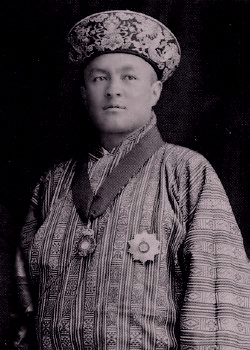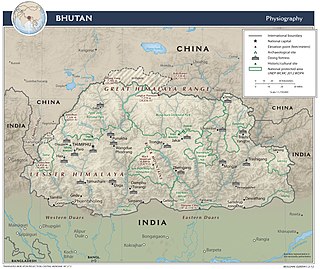
Bhutan's early history is steeped in mythology and remains obscure. Some of the structures provide evidence that the region has been settled as early as 2000 BC. According to a legend it was ruled by a Cooch-Behar king, Sangaldip, around the 7th century BC, but not much is known prior to the introduction of Tibetan Buddhism in the 9th century, when turmoil in Tibet forced many monks to flee to Bhutan. In the 12th century, the Drukpa Kagyupa school was established and remains the dominant form of Buddhism in Bhutan today. The country's political history is intimately tied to its religious history and relations among the various monastic schools and monasteries.

Jigme Wangchuck was the 2nd Druk Gyalpo or king of Bhutan from 26 August 1926, until his death. He pursued legal and infrastructural reform during his reign. Bhutan continued to maintain almost complete isolation from the outside world during this period; its only foreign relations were with the British Raj in India, under which Bhutan was a protected state. He was succeeded by his son, Jigme Dorji Wangchuck.

Jigme Dorji Wangchuck was the 3rd Druk Gyalpo of Bhutan.

Zhabdrung was a title used when referring to or addressing great lamas in Tibet, particularly those who held a hereditary lineage. In Bhutan the title almost always refers to Ngawang Namgyal (1594–1651), the founder of the Bhutanese state, or one of his successive reincarnations.

LyonpoSangay Ngedup was Prime Minister of Bhutan from 1999 to 2000 and again from 2005 to 2006.

The Duar War was a war fought between British India and Bhutan in 1864 to 1865. It has been the only military conflict between the two states since 1774.

Gongsar Ugyen Wangchuck was the first Druk Gyalpo (King) of Bhutan from 1907 to 1926. In his lifetime, he made efforts to unite the fledgling country and gain the trust of the people.

The Wangchuck dynasty have held the hereditary position of Druk Gyalpo of Bhutan since 1907. Prior to reunification, the Wangchuck family had governed the district of Trongsa as descendants of Dungkar Choji. They eventually overpowered other regional lords and earned the favour of the British Empire. After consolidating power, the 12th Penlop of Trongsa Gongsar Ugyen Wangchuck was elected Druk Gyalpo, thus founding the dynasty. The position of Druk Gyalpo – who heads the royal family of Bhutan – is more commonly known in English as the King of Bhutan, however "Druk Gyalpo" would be translated literally as "Dragon King"

Penlop is a Dzongkha term roughly translated as provincial governor. Bhutanese penlops, prior to unification, controlled certain districts of the country, but now hold no administrative office. Rather, penlops are now entirely subservient to the House of Wangchuck.

The following outline is provided as an overview of and topical guide to Bhutan:

Slavery in Bhutan was a common legal, economic, and social institution until its abolition in 1958. In historical records, unfree labourers in Bhutan were referred to as slaves, coolies, and serfs. These labourers originated mostly in and around Bhutan, Assam, and Sikkim, and were the backbone of Bhutan's pre-money feudal economy.
The Dorji family of Bhutan has been a prominent and powerful political family in the kingdom since the 12th century AD. The family has produced monarchs, Prime Minister of Bhutan, Prime Ministers, Dzong lords and governors. The fourth king of Bhutan Druk Gyalpo, Jigme Singye Wangchuck, as well as his son the current fifth king of Bhutan Jigme Khesar Namgyel Wangchuck, are also members of the Dorji family and therefore also descendants of the royal family of Sikkim. The Dorji family is also the holder of the Bhutan House estate in Kalimpong, India.
Bhutan House is an estate located in Kalimpong, West Bengal, India, owned by the Dorji family of Bhutan. The site is the traditional administrative Dzong for southern Bhutan, and also functioned as the administrative center for the whole of western Bhutan during the modern kingdom's early years of consolidation. It represented the relationship between Bhutan and British India, and is a modern symbol of Bhutan–India relations.
Sir Raja Sonam Topgay Dorji CIE, also called Tobgay, was a member of the Dorji family and Bhutanese politician who served between 1917 and 1952 in the Royal Government under the First and Second Kings of Bhutan. During this period, Topgay Dorji officially held the posts of Gongzim, Deb Zimpon, and Trade Agent to the Government of Bhutan. As such, Topgay Dorji was responsible for fostering Anglo-Bhutanese relations, and later, Bhutan–India relations. Topgay's ties with the west and modernist political factions contributed significantly to the modern political landscape and modernization of Bhutan.

Ugyen Dorji was a member of the elite Dorji family and an influential Bhutanese politician. He served as the closest adviser to Ugyen Wangchuck, the Penlop of Trongsa and later King of Bhutan. Ugyen Dorji was instrumental in fostering friendly relations with the British after the Bhutan War (1864–1865), and providing support to the British expedition to Tibet in 1904. Operating from Bhutan House in Kalimpong, India, Ugyen Dorji used his position to open Bhutan to the outside world, establish Bhutan's foreign relations, and operate a lucrative trading outlet.

Desi Jigme Namgyal of Bhutan is a forefather of the Wangchuck Dynasty. He served as 51st Druk Desi of Bhutan (1870–1873), and held the hereditary post of 10th Penlop of Trongsa. He was called the Black Ruler.

The military history of Bhutan begins with the Battle of Five Lamas in 1634, marking Bhutan's emergence as a nation under the secular and religious leadership of Zhabdrung Ngawang Namgyal. Before Bhutan emerged as a separate nation, it remained on the periphery of Tibetan military and political influence. The region that became Bhutan was host to several battles and waves of refugees from turmoil in Tibet. After its founding, Bhutan was invaded numerous times by outside forces, namely Tibetans, Mongols, and the British. Bhutan meanwhile invaded its traditional tributaries in Sikkim, Cooch Behar, and the Duars.

The Bhutan–India border is the open international border separating the Kingdom of Bhutan from the Republic of India. The border is 699 km long, and adjoins the Indian states of Assam, Arunachal Pradesh, West Bengal, and Sikkim.

Kalimpong district is a district in the state of West Bengal, India. In 2017, it was carved out as a separate district to become the 21st district of West Bengal.















